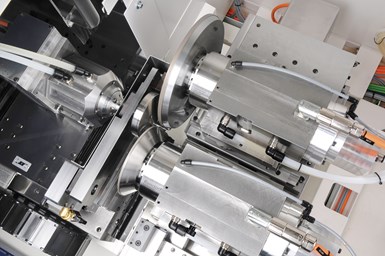Rollomatic Unveils Double Rough Pinch Grinding Process
Rollomatic has debuted its double rough pinch grinding process, which it says cuts cycle times and increases performance and thermal stability.

Rollomatic, the original inventor of pinch and peel grinding, has developed a new “double rough pinch grinding” process to decrease cycle times for blank preparation of several carbide cutting tools.
Pinch grinding specializes in blank and tight surface finishes. The roughing and finishing wheels grind parts simultaneously, with the finishing wheel trailing the roughing wheel to perform both rough and finish grinding in one pass and reduce cycle times.
In double rough pinch grinding, users equip both grinding stations with diamond wheels with a grit size normally used for rough grinding. This leaves the blank “pinched” between two rough-grit diamond wheels, which then work simultaneously on the blank. While one wheel does the majority of the work, the second wheel cleans up what was left. This process further shortens the cycle times of the customary pinch grinding method.
Rollomatic recommends its new process when preparing T-slot cutters, thread end mills, end mills for die and mold machining, long-reach end mills and rotary burs. It also recommends the process for long-batch production.
Both grinding spindles are synchronous direct‐drive spindles with 19 hp peaks. The most important feature of a synchronous motor is that it provides constant speed during its operation with an efficient torque curve. Synchronous motors always run equal to their synchronous speed, as opposed to less-efficient asynchronous motors (induction motors) which always have a lag.
On a test production run of 100 pieces, the process achieved a cycle time (without loading or unloading) of 5 minutes and 5 seconds. Wheel spindle load never broke 35 percent, with wheel wear as the limiting factor rather than the machine. At a 35-percent power draw, the spindles did not release heat into the machine or grinding process – improving thermal stability. Rollomatic says the process outperformed alternative competitive equipment by 50 percent.
Related Content
-
10 Things to Know About Creep-Feed Grinding
Because of the high material removal rate creep-feed grinding can deliver in challenging materials, grinding might not be just the last step in the process—it might be the process.
-
Volumetric Accuracy Is Key to Machining James Webb Telescope
To meet the extreme tolerance of the telescope’s beryllium mirrors, the manufacturer had to rely on stable horizontal machining centers with a high degree of consistency volumetric accuracy.
-
A New Milling 101: Milling Forces and Formulas
The forces involved in the milling process can be quantified, thus allowing mathematical tools to predict and control these forces. Formulas for calculating these forces accurately make it possible to optimize the quality of milling operations.
.jpg;maxWidth=970;quality=90)







.jpg;maxWidth=300;quality=90)







.jpg;maxWidth=970;quality=90)